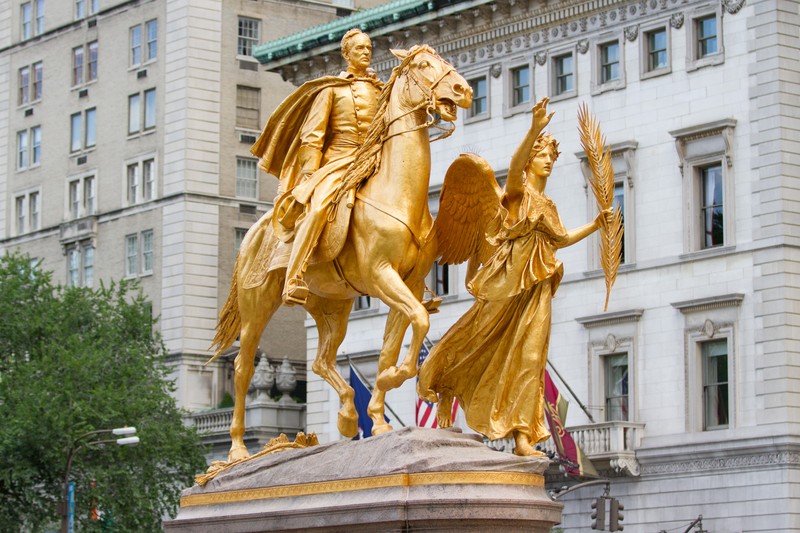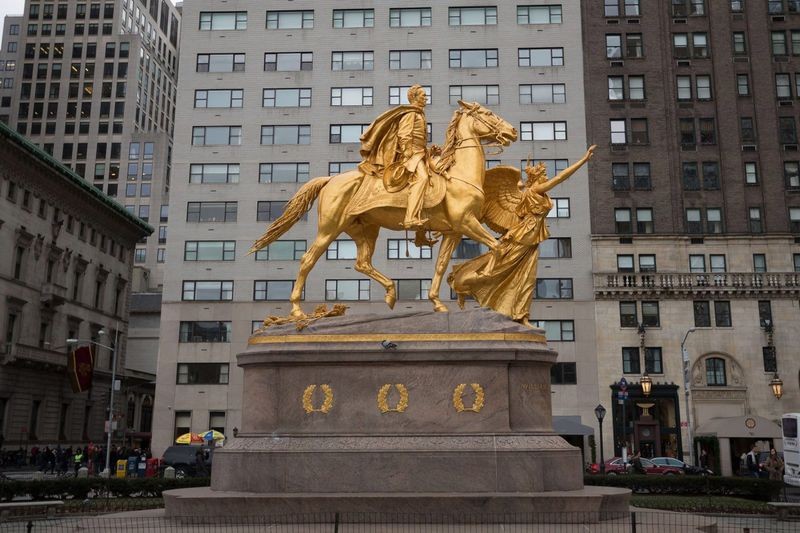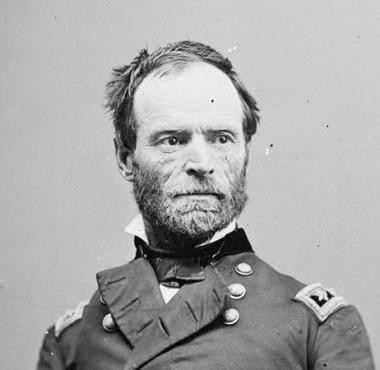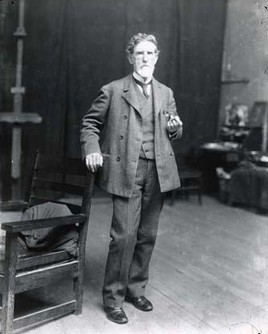William Tecumseh Sherman Monument
Introduction
Text-to-speech Audio
Images
William Tecumseh Sherman Monument in Manhattan's Grand Army Plaza

A side view of the monument

William Tecumseh Sherman (1820-1891)

Augustus Saint-Gaudens (1848-1907)

Backstory and Context
Text-to-speech Audio
William Tecumseh Sherman was born into a prominent family in Lancaster, Ohio on February 8, 1820. His father, Charles R. Sherman, was a justice on the Supreme Court of Ohio. In 1829, Sherman’s father died unexpectedly. Soon after, he was sent to live with family friend, lawyer, and budding Whig politician, Thomas Ewing. When Sherman was sixteen years old, Ewing secured for him an appointment to the United States Military Academy at West Point. Four years later, in 1840, Sherman graduated near the top of his class.
After graduating from West Point, Sherman fought in the Second Seminole War in Florida before being transferred to Fort Moultrie on Sullivan’s Island at the entrance to Charleston Harbor. Unlike many generals of the Civil War, he did not serve in the Mexican War. In 1850, Sherman married Ellen Ewing, the daughter of Thomas Ewing, in Washington, D.C. The couple settled in St. Louis. Three years later, Sherman resigned from the military to pursue a business career. The Panic of 1857, however, derailed his plans. He then relied on two friends from the South, Braxton Bragg and P.G.T. Beauregard, to secure for him the position of superintendent at the newly founded Louisiana State Seminary of Learning and Military Academy (now Louisiana State University) in 1859.
When Louisiana seceded from the Union in January 1861, Sherman resigned from the position and returned to St. Louis. With the help of his younger brother, Senator John Sherman, he secured a commission as a colonel in the Union Army that spring. Sherman commanded a brigade at the First Battle of Bull Run and afterward received a promotion to the rank of brigadier general. He then briefly helped to oversee the federal occupation of Kentucky before becoming a divisional commander under General Ulysses S. Grant. In the spring of 1862, Sherman participated in the Battle of Shiloh and shortly after received a promotion to the rank of major general. The following year, while commanding XV Corps, he helped Grant capture Vicksburg, which gave the Union complete command of the Mississippi River.
During the final two years of the conflict, Sherman brought the war to the Deep South and, through hard war policies, struck a blow against the Confederacy’s ability to wage war. In May 1864, he invaded Georgia, capturing Atlanta on September 2. Sherman then commenced his famous “March to the Sea.” In November and December 1864, his army trampled through the heart of Georgia, destroying rail lines, toppling telegraph poles, burning factories, and stealing food and supplies along the way. By Christmas, Sherman had captured Savannah. In early 1865, he turned northward and invaded the Carolinas. Sherman captured Columbia on February 17 and defeated Confederate General Joseph E. Johnston at the Battle of Bentonville the following month. On April 26, 1865, Johnston surrendered his army along with all Confederate troops in Georgia, Florida, and the Carolinas to Sherman. It was the largest surrender of southern forces during the war.
After the war, Sherman remained in the military and was promoted to the rank of lieutenant general in 1866. When Grant became President of the United States in 1869, Sherman became the commanding general of the U.S. Army, a position he would hold until 1883. He died in New York City in 1891 at the age of seventy-one.
Shortly after Sherman’s death, his friends in the New York Chamber of Commerce appointed a committee to raise funds for the erection of a monument in honor of the Civil War hero. In 1892, the committee commissioned esteemed sculptor Augustus Saint-Gaudens and architect Charles McKim to design the statue and pedestal, respectively. Unveiled in Manhattan’s Grand Army Plaza on May 30, 1903, the monument consists of a larger-than-life-sized gilded bronze equestrian statue of Sherman led by a female allegorical figure representing “Peace.” The two sculptures rest on an oblong, pink granite pedestal adorned with six gilded bronze wreaths. The original plan was to install the monument in Riverside Park near Grant’s tomb. Sherman’s family, however, objected to the idea and later settled on Grand Army Plaza.
Cite This Entry
Curran, Francis. "William Tecumseh Sherman Monument." Clio: Your Guide to History. February 11, 2021. Accessed March 20, 2025. https://theclio.com/tour/1799/1
Sources
Tebeau, Charlton W. "William Tecumseh Sherman." Encyclopædia Britannica. Web. 10 February 2021 <https://www.britannica.com/biography/William-Tecumseh-Sherman>.
"William T. Sherman." American Battlefield Trust. Web. 10 February 2021 <https://www.battlefields.org/learn/biographies/william-t-sherman>.
"William Tecumseh Sherman." Central Park Conservancy. Web. 10 February 2021 <https://www.centralparknyc.org/locations/william-tecumseh-sherman>.
"William Tecumseh Sherman." New York City Department of Parks and Recreation. The City of New York. Web. 10 February 2021 <https://www.nycgovparks.org/parks/grand-army-plaza-m062/monuments/1442>.
https://www.centralparkinbronze.com/william-tecumseh-sherman
https://www.nydailynews.com/new-york/city-remove-nyc-iconic-statues-article-1.3464427
https://www.battlefields.org/learn/biographies/william-t-sherman
https://americanart.si.edu/artist/augustus-saint-gaudens-4213

